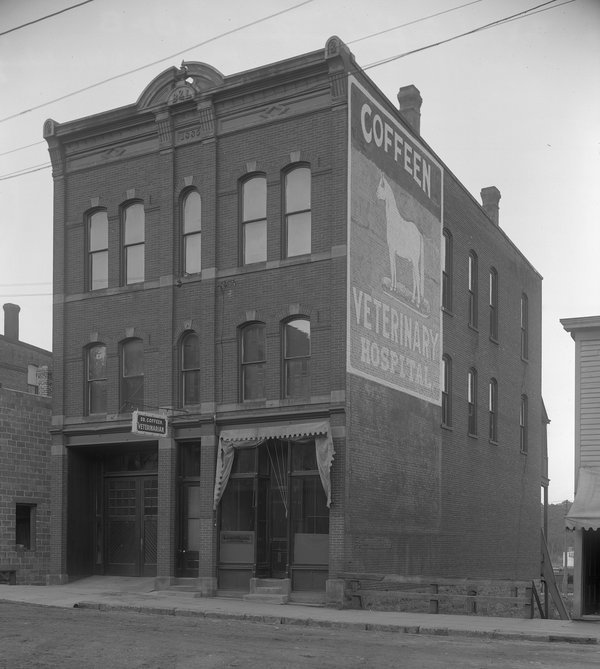Boo & Lindbloom Block
The Boo & Lindbloom Block, built in 1885, has seen many uses: a fraternal and social hall, retail, veterinary hospital, farm machinery dealership, and office building. Though significantly reduced from its original size, in recent years the building has returned to its original use as an event space.
Retail and Event Space
In 1882, Scandinavian immigrants in Stillwater formed a new organization called Society Norden. Two years later, a newspaper correspondent noted that the group had done much to keep the Scandinavian people together: “It has now grown to large proportions, and they are educating the rising generation in a love for the old land and its history.” However, a different newspaper reported rumors that the group would disband.[1]
Within weeks, Society Norden made a statement about its future by leasing space in a new three-story brick building being constructed by Swedish immigrants Charles Boo and Charles Lindbloom. Boo operated a saloon across Second Street, and his brother-in-law Lindbloom operated a confectionary and tobacco store on the same block. Stillwater Messenger reported that “new life has lately been breathed” into Society Norden as it leased space in the new building.[2]
The Knights of Labor organization was another original tenant. The Stillwater Messenger described the organization in 1886:
The local assembly of the Knights of Labor, which has quietly grown until it has a membership of several hundred industrious, intelligent, and for the most part temperate mechanics and laboring men, recently established a reading room in its hall in the Boo & Lindbloom building for the benefit of its members, where can be found a small of choice collection of papers and magazines, and more solid works will be added from time to time. At present the room is only open Sunday afternoons, but should those for whose benefit the enterprise is inaugurated show a sufficient interest to warrant the increased expense the room will be open evenings. While the object is mainly to benefit members of the order, non-members are cordially invited to visit the reading room whenever so inclined and participate in the benefits.[3]
The organization and social spaces were on the upper floors, along with living quarters. The first floor contained two retail stores. In 1892, for example, Charles Boo sold men’s clothing in one store space, while John A. Nordstrom had a confectionary store in the other space. (By that time, original partner Charles Lindbloom was working as a clerk at the post office, and Boo purchased Lindbloom’s half interest in 1893.) A fire in 1891 caused “merely nominal” damage to the building but destroyed most of Boo’s inventory of men’s clothing and furnishing goods.[4]
The 1880s and 1890s saw the hall used for a variety of political and social activities. In July 1888, the hall used by the Norwegian Ski Club, who were being drilled to “so accustom the members to military evolutions that they may be able to show some graceful and precise movements while on the move in next winter’s parades.” The same week saw the hall used for a “mass prohibition convention” to form a new anti-alcohol organization. In the 1890s, the hall hosted other public meetings to promote prohibition and anti-corruption political reform. As late as 1898, it was used for an informal meeting of Republicans to discuss their mayoral nomination.[5]
Veterinary Hospital
In 1916, Charles Boo sold the building to Dr. Robert J. Coffeen, who adapted the structure to serve as his veterinary hospital and residence. The Stillwater Messenger described the updated facility:
The building has a double front and on one side has been placed a double door which leads into the main part on the first floor. The other half of the main floor will be for office and medicine room, the basement, which is light and airy is being fitted up for stabling animals. The second story is for living room and the top floor will be for a kennel hospital…. When it is finished Stillwater will have one of the largest and commodious hospitals of its kind in the northwest.
Coffeen told the newspaper that he had frequently turned away cat and dog patients because he did not have the space, but now would be able to treat them. In 1921, Coffeen expanded the building with a rear addition.[6]
In 1927, Coffeen completed a term as Stillwater’s mayor and moved his home and practice out of the city, to Oak Park. In 1928, Coffeen was appointed as the head of the state board responsible for examining prospective veterinarians. Early in the Great Depression, Coffeen ceased paying taxes on the Boo & Lindbloom building and it became state property.[7]
Farm Equipment Dealership
After nearly a decade of state ownership, J. Ernest Beaudet purchased the Boo & Lindbloom building in 1939. In 1940, Beaudet received a building permit to demolish the top two stories, replace the roof and built up the front wall. At the time, Beaudet was unsure of the building’s future use.[8]
By 1942, the building was occupied by the Stillwater Implement & Supply Company owned by Axel R. Holberg and Elmore T. Johnson. In 1948, the agricultural implements dealership was owned by Reuben E. and David R. Carlson. The Carlsons carried International Harvester and McCormick-Deering equipment, and advertised a specialty in overhauling tractors. In 1956, the company was known as Stillwater Farm Equipment Co. and its president was Walter E. Carlson. It remained in the Boo & Lindbloom building until relocating across the river to Houlton sometime between 1962 and 1964.[9]
Office Building
Starting around 1964, the Boo & Lindbloom building was used as a multi-tenant office building. That year, it was occupied by Dean Charlsen’s insurance agency and sign shop, as well as Roy A. Torelle’s St. Croix Radio & TV service shop. By 1980, the tenants were Charlsen Insurance (now led by Kevin J. Charlsen), Ronald L. Axdahl’s Rivertown Tool, and Valley Yarnsmith (Nancy and Dean Schell). By 1988, the building was known as Rivertown Offices.[10]
Event Space
Most recently, the building returned to one of its original uses: an event space. In 2017, the Boo & Lindbloom Hall building was purchased by the developers of the Hotel Crosby for use as a construction office. Since the hotel’s completion, the space has been used as an event rental space known as The Stills, as well as the hotel’s offices.[11]
References
-
St. Paul Daily Globe, 25 February 1882, 27 May 1885. Stillwater Messenger 23 May 1885.
↩ -
Stillwater Messenger 15 April 1885, 20 June 1885. 1880 U.S. Census. 1884 Stillwater City Directory.
↩ -
Messenger 21 August 1886.
↩ -
1891 and 1898 Sanborn fire insurance maps of Stillwater. 1892 Stillwater City Directory. Washington County, 38 Deeds 37.
↩ -
Messenger 14 July 1888, 30 August 1890, 10 March 1894, 1 October 1898.
↩ -
Stillwater Daily Gazette 22 May 1916. Stillwater Messenger 10 June 1916. City of Stillwater, Building Permit Applications 1630, 1866. Robert J. Coffeen in 1920 U.S. Census for Stillwater.
↩ -
Stillwater Daily Gazette, 3 January 1927, 7 December 1927, 18 June 1928. Washington County Recorder, 130 Deeds 211, 141 Deeds 60. 1927 Stillwater City Directory.
↩ -
Washington County Recorder, 141 Deeds 60. City of Stillwater, Building Permit Application 2573.
↩ -
Stillwater City Directory, 1942, 1948, 1956, 1962, 1964.
↩ -
Stillwater City Directory, 1964, 1970, 1980, 1988.
↩ -
City of Stillwater, Report to the Planning Commission, December 12, 2019.
↩

